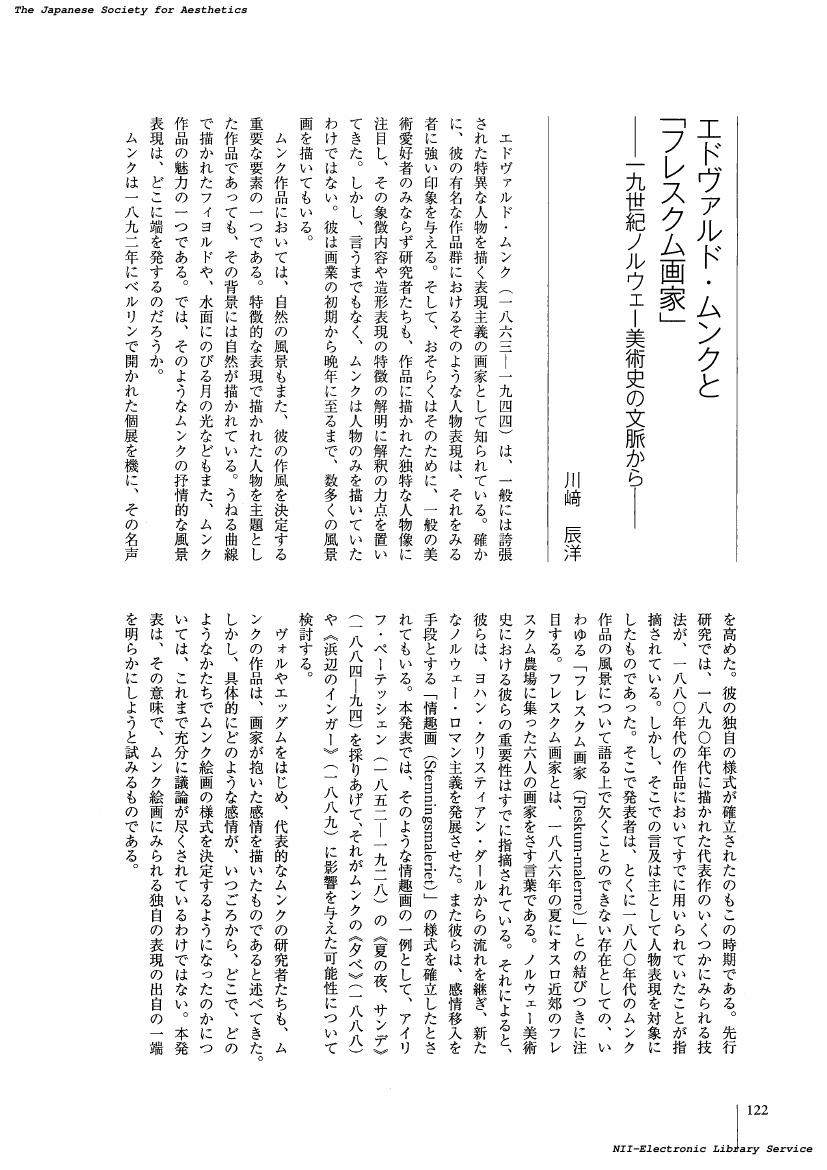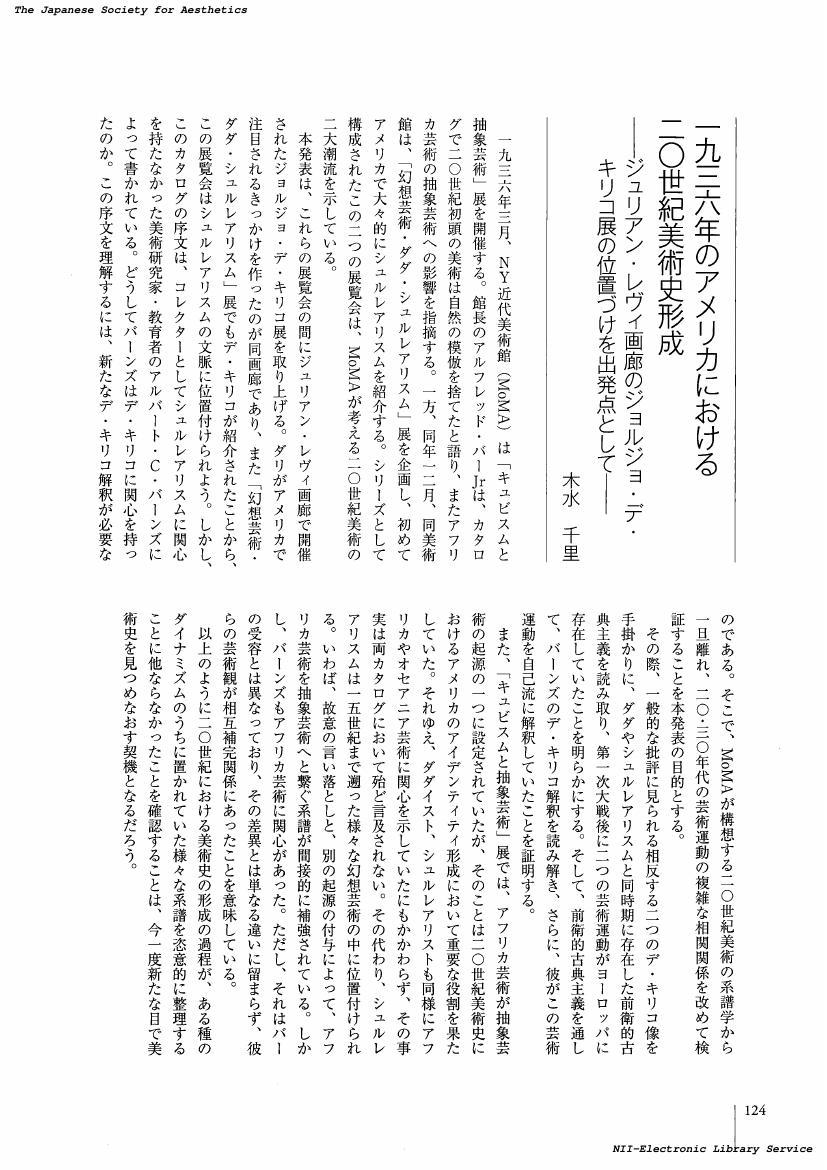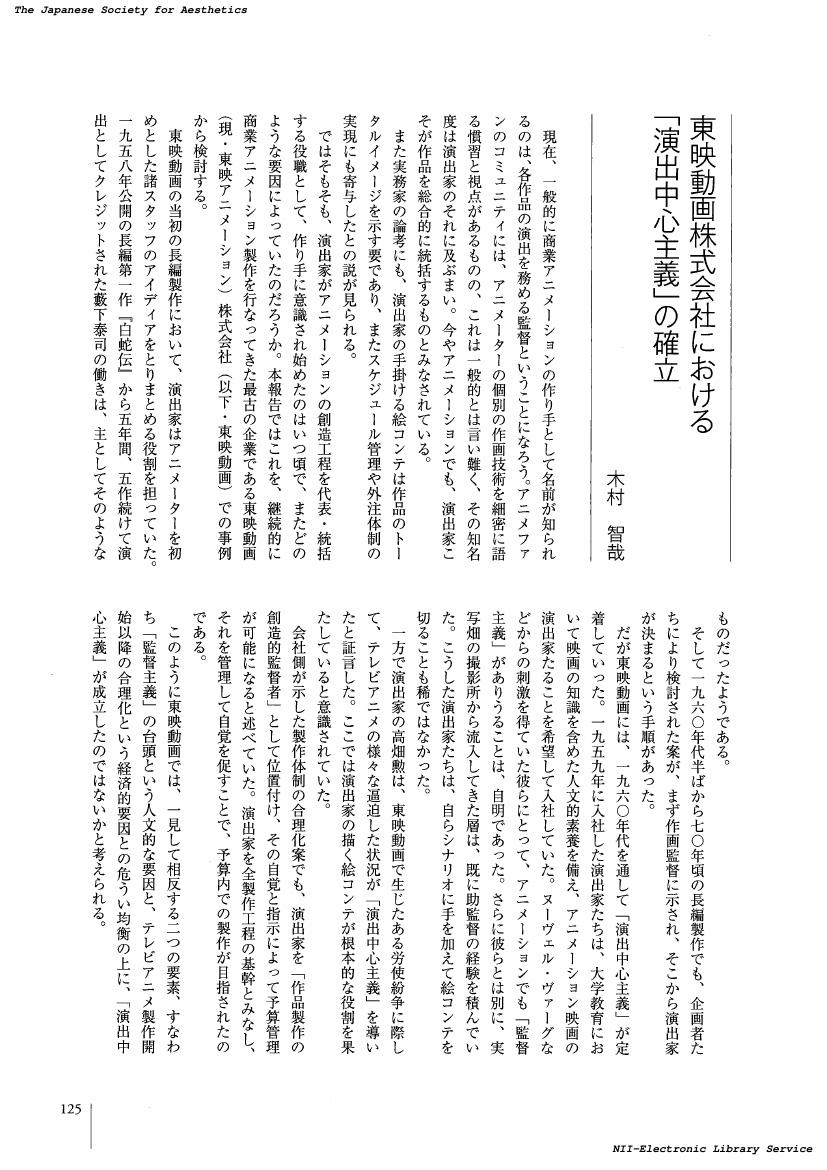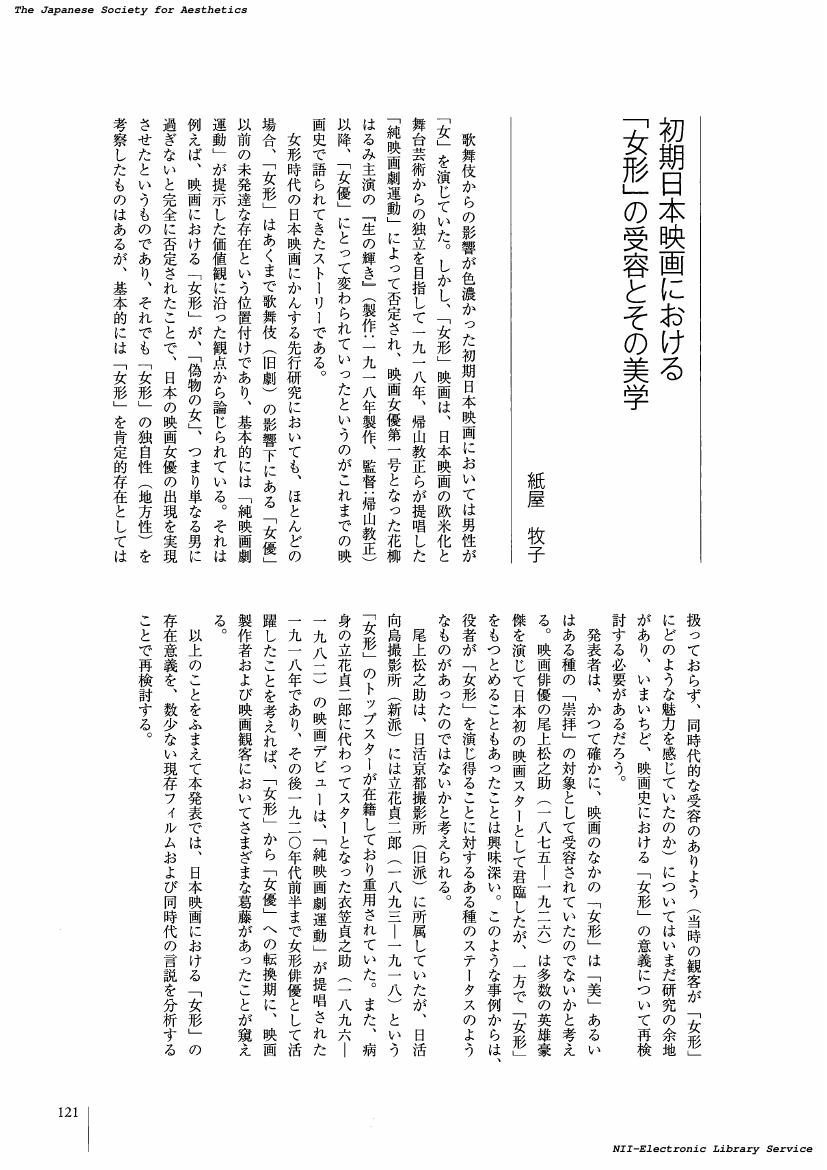- 著者
- 山本 佐恵
- 出版者
- 美学会
- 雑誌
- 美学 (ISSN:05200962)
- 巻号頁・発行日
- vol.66, no.2, pp.139, 2015-12-31 (Released:2017-05-22)
- 著者
- 横道 仁志
- 出版者
- 美学会
- 雑誌
- 美学 (ISSN:05200962)
- 巻号頁・発行日
- vol.66, no.2, pp.140, 2015-12-31 (Released:2017-05-22)
- 著者
- 川崎 辰洋
- 出版者
- 美学会
- 雑誌
- 美学 (ISSN:05200962)
- 巻号頁・発行日
- vol.66, no.2, pp.122, 2015-12-31 (Released:2017-05-22)
- 著者
- 川野 惠子
- 出版者
- 美学会
- 雑誌
- 美学 (ISSN:05200962)
- 巻号頁・発行日
- vol.66, no.2, pp.123, 2015-12-31 (Released:2017-05-22)
- 著者
- 木水 千里
- 出版者
- 美学会
- 雑誌
- 美学 (ISSN:05200962)
- 巻号頁・発行日
- vol.66, no.2, pp.124, 2015-12-31 (Released:2017-05-22)
1 0 0 0 OA 東映動画株式会社における「演出中心主義」の確立(第六十六回美学会全国大会発表要旨)
- 著者
- 木村 智哉
- 出版者
- 美学会
- 雑誌
- 美学 (ISSN:05200962)
- 巻号頁・発行日
- vol.66, no.2, pp.125, 2015-12-31 (Released:2017-05-22)
- 著者
- 久保田 有寿
- 出版者
- 美学会
- 雑誌
- 美学 (ISSN:05200962)
- 巻号頁・発行日
- vol.66, no.2, pp.126, 2015-12-31 (Released:2017-05-22)
- 著者
- 島村 幸忠
- 出版者
- 美学会
- 雑誌
- 美学 (ISSN:05200962)
- 巻号頁・発行日
- vol.66, no.2, pp.127, 2015-12-31 (Released:2017-05-22)
1 0 0 0 OA フィリップ・メランヒトンの絵画・図像論(第六十六回美学会全国大会発表要旨)
- 著者
- 下山 大助
- 出版者
- 美学会
- 雑誌
- 美学 (ISSN:05200962)
- 巻号頁・発行日
- vol.66, no.2, pp.128, 2015-12-31 (Released:2017-05-22)
- 著者
- 利根川 由奈
- 出版者
- 美学会
- 雑誌
- 美学 (ISSN:05200962)
- 巻号頁・発行日
- vol.66, no.2, pp.129, 2015-12-31 (Released:2017-05-22)
1 0 0 0 OA G・ブルレの音楽美学史的位置づけ : E・ハンスリックとの関係を通じて
- 著者
- 舩木 理悠
- 出版者
- 美学会
- 雑誌
- 美学 (ISSN:05200962)
- 巻号頁・発行日
- vol.66, no.2, pp.97-107, 2015-12-31 (Released:2017-05-22)
Gisele Brelet (1915-73), a French musicologist, is known for her study of time in music, Le Temps musical - essai d'une esthetique nouvelle de la musique (1949). Accordingly, earlier studies of Brelet are mainly focused on her concept of le temps musical, and few evaluate her aesthetics in a historical context. This paper aims at placing Brelet in that context by examining her remarks on Eduard Hanslick (1825-1904), the author of Vom Musikalisch-Schonen (1854), known as the father of modern musical aesthetics. Brelet argues that Hanslick's aesthetics is negatif, and claims her work can renovate it. First, this paper analyzes Brelet's statements to show how she interprets Hanslick's theory as 'temporal.' Second, it analyses her interpretation with reference to Hanslick's text, before pointing out the lack of attention given to 'the temporal', which later led to the negligence of it in musicology, consequently causing many difficulties in this field today. This paper concludes that Brelet's aesthetics, criticizing the weak points in Hanslick's theory, enable us to view the problems in modern and contemporary musical aesthetics in a new perspective.
- 著者
- 阿部 美由起
- 出版者
- 美学会
- 雑誌
- 美学 (ISSN:05200962)
- 巻号頁・発行日
- vol.66, no.2, pp.114, 2015-12-31 (Released:2017-05-22)
- 著者
- 鮎川 真由美
- 出版者
- 美学会
- 雑誌
- 美学 (ISSN:05200962)
- 巻号頁・発行日
- vol.66, no.2, pp.115, 2015-12-31 (Released:2017-05-22)
- 著者
- 伊野 連
- 出版者
- 美学会
- 雑誌
- 美学 (ISSN:05200962)
- 巻号頁・発行日
- vol.66, no.2, pp.117, 2015-12-31 (Released:2017-05-22)
- 著者
- 越前 俊也
- 出版者
- 美学会
- 雑誌
- 美学 (ISSN:05200962)
- 巻号頁・発行日
- vol.66, no.2, pp.118, 2015-12-31 (Released:2017-05-22)
- 著者
- 甲斐 義明
- 出版者
- 美学会
- 雑誌
- 美学 (ISSN:05200962)
- 巻号頁・発行日
- vol.66, no.2, pp.119, 2015-12-31 (Released:2017-05-22)
1 0 0 0 OA 初期日本映画における「女形」の受容とその美学(第六十六回美学会全国大会発表要旨)
- 著者
- 紙屋 牧子
- 出版者
- 美学会
- 雑誌
- 美学 (ISSN:05200962)
- 巻号頁・発行日
- vol.66, no.2, pp.121, 2015-12-31 (Released:2017-05-22)
- 著者
- 桑原 俊介
- 出版者
- 美学会
- 雑誌
- 美学 (ISSN:05200962)
- 巻号頁・発行日
- vol.66, no.2, pp.1-12, 2015-12-31 (Released:2017-05-19)
In dieser Abhandlung wird bewiesen, dass die Erweiterung der Wahrheit seit der sogennanten "probabilistischen Revolution" (Hacking) Mitte des 17. Jahrhunderts, die Ausdehnung derselben von der (strengen) "Wahrheit (veritas)" zu der "Wahrscheinlichkeit (probabilitas, verisimilitudo)", ein Moment fur die Entstehung der Asthetik Baumgartens gewesen ist. Das wissenschaftliche Wissen (scientia) blieb, besonders seit Descartes, streng auf die Wahrheit beschrankt, die nur durch die deduktive Demonstration ermittelt wird, wahrend die Wahrscheinlichkeit, die nur durch die "Autoritat" oder "Billigung" durch andere bestand, vom Bereich des wissenschaftlichen Wissens vollkommen ausgeschlossen war. Jedoch, wenn der Wahrscheinlichkeitsbegriff durch jene Revolution mathematisch oder statistisch, also quantitativ neu formuliert werden wurde, wurde das Wahrscheinliche nicht nur in der Mathematik sondern auch in der Logik als "der Grad der Wahrheit" quantitativ behandelt werden konnen. Es konnte ein Moment fur die Entstehung der Asthetik Baumgartens sein, dass er diesen quantitativen neuen Wahrscheinlichkeitsbegriff in seine Asthetik aufgenommen und mit ihm den Begriff der "verisimilitudo" in seiner eigenen Weise bestimmt hat.
- 著者
- 坂田 奈々絵
- 出版者
- 美学会
- 雑誌
- 美学 (ISSN:05200962)
- 巻号頁・発行日
- vol.66, no.2, pp.13-24, 2015-12-31 (Released:2017-05-22)
Abbot Suger led the rebuilding of the Abbey of Saint-Denis in the twelfth century. He recorded his theological ideas about the new building and the love of jewels and gold. E. Panofsky has described this document as expressing typical medieval aesthetic ideas. In the same age, Bernard of Clairvaux worked to reform monasticism. He thought that the luxuries of monastic buildings and churches were contrary to the rules of Benedict. Both of these abbots considered art to be a spiritual aide, and thought that the use of art in religious buildings was meaningful. However, Suger had an optimistic view of the use of "the materials" and arts, whereas Bernard was more cautious. We can argue that these differences stem from their contrasting views of liturgy. For these men, liturgical theology was a basis for the theory of the material world, and art in particular. Suger argued that liturgy represented a harmony between the material and the immaterial, emphasizing the incarnation and creation of God in the liturgy. In this way, he paid attention to the way that material things were used in the service of God, and saw their secular value as also representing their suitableness for God. However, Bernard emphasized the relation between liturgies, congregations, and symbols. He regarded the spiritual attitude of the congregation as more important, and argued that liturgical ceremony itself does not produce sanctity. He also argued that material treasures such as jewels were potentialy dangerous.
- 著者
- 百合草 真理子
- 出版者
- 美学会
- 雑誌
- 美学 (ISSN:05200962)
- 巻号頁・発行日
- vol.66, no.2, pp.25-36, 2015-12-31 (Released:2017-05-22)
From 1520 to 1524, Antonio Allegri da Correggio (1489-1534) depicted the Second Coming on the cupola in San Giovanni Evangelista in Parma. This painting has been pointed out the formal relationship to Raffael's "Transfiguration" (1518-20). Though it has been over looked its theological significance, according to St. Bede, the transfigured Christ not only prefigured his outward appearance at the Second Coming, but also related to the resurrection of Christ and the Elect. In the early 16^<th> century, especially in Italy, the Transfiguration, the Resurrection and the Ascension that implies a reference to his Second Coming were conflated by lifting Chirst off the ground. From this iconograhic tradition and the liturgical context of San Giovanni Evangelista, I consider that Correggio adopted the Transfiguration type for the Second Coming on purpose to represent the glory revealed by his resurrection. Moreover, the subjects for the western cupola and the apse, the Transition of St. John Evangelist and the Coronation of Virgin, mean that the image of Christ on the ceiling, which underscores his human body, reminded the viewer of his own resurrection that would take place in the future. Consequently, I conclude that the cupola represents Christ's nature as both God and man, in contrast to the precedent view that read only his divinity there.















